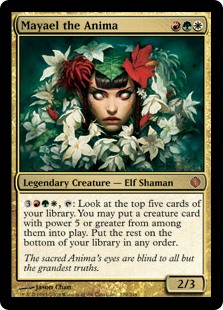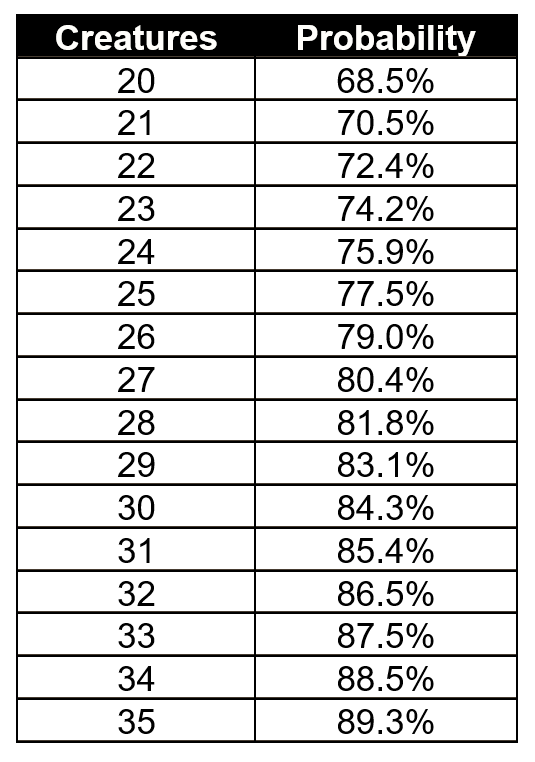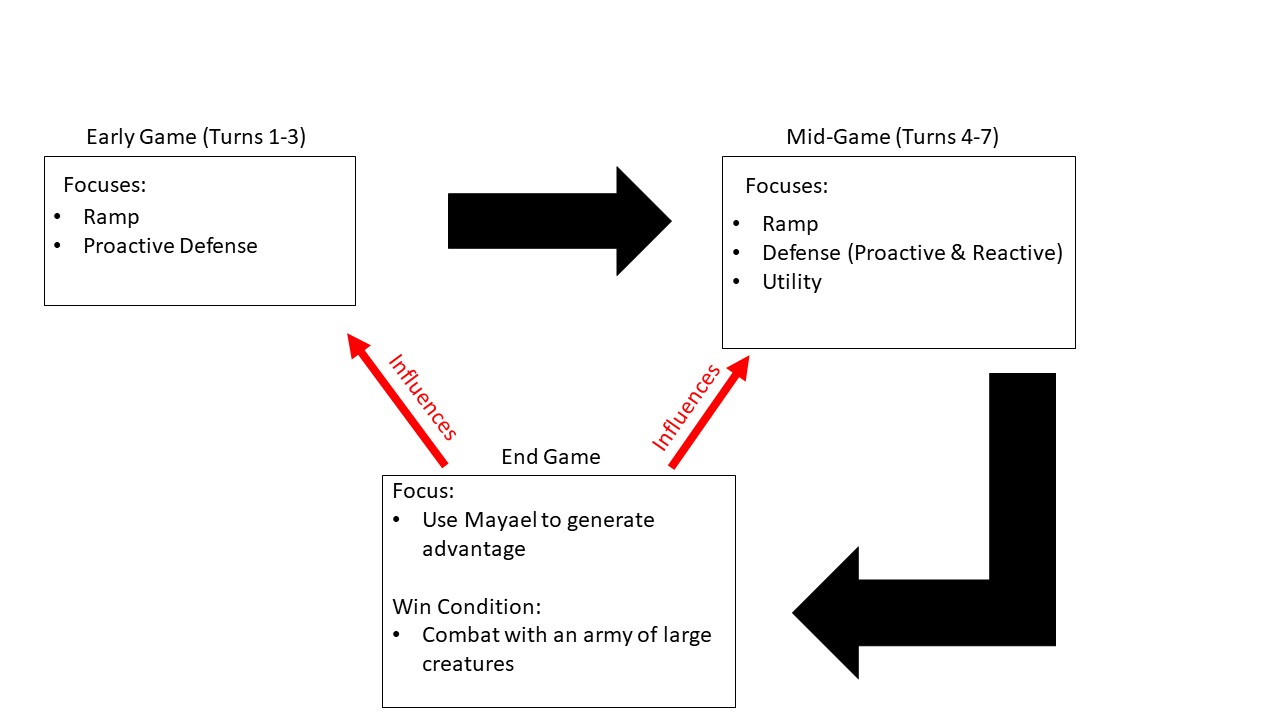The Knowledge Pool — Mayael the Anima Part 1
Hi everyone! I’m Scot, and I want to welcome you to The Knowledge Pool. In this series I want to discuss deckbuilding theory and the elements that we can implement to make our decks more consistently competitive in our respective metas. I will walk you through the approaches that work for me with the hope that you might consider them when building your own decks.
Before I get into the bulk of this week’s content, I want to give you a little bit of background on myself. I began playing Magic heavily during Zendikar-Scars block right at the emergence of the Caw-Blade menace. I quickly made the transition to Modern and Commander in 2012. My time playing Jund has weighed heavily on my approach to Commander. I tend towards a conservative approach to card selection, and I tend to favor efficient cards with a high floor. During the past five years I’ve made the shift to Legacy, but Commander has eclipsed all other formats as my primary Magic outlet. For me, Commander lets me express myself more than any other format. I love brewing decks, and I’m constantly day dreaming new strategies and considering new approaches to this game I love. The longer I’ve played, the more I’ve realized that I’m best associated with the Timmy mentality: I love playing decks that do “big” things. Unsurprisingly, I’m also a primarily Green player, and I love playing lands and creatures.
I typically play in a moderately competitive and somewhat large community. Most players in my playgroup have been active MTG players for several years, and typically each player comes prepared with a variety of decks ranging in potency from those with the ability to kill on turn 4, to those that are designed with the 75% theory in mind. Given the wealth of diversity in my playgroup, I’ve been forced to hone my deck building skills and design my decks such that they can hold their own in most situations.
This brings me to a critical element of this series: I don’t have all the answers, nor do I believe my suggestions should be interpreted as gospel. In my opinion, Commander is a format without definitive answers. There are a near infinite number of card combinations that can be successful in each deck, and ultimately the cards we play come down to personal preference. Even the cards often considered to be superior in a general sense can be invalidated by a hostile metagame. However, approaching our commander with an analytical scope and considering the implications of each stage of gameplay can help us to make more informed choices as we decide on our final 99. Ideally, this series will inspire discussion. I want to hear what you all think regarding the suggestions I make, and I want to hear what has worked well for you and why.
Without further ado, I would like to introduce our commander of interest for this week: Mayael the Anima.

For most Commander players, Mayael is not a surprising choice in the Naya colors as indicated by her being the most played Naya commander according to EDHrec with 1305 decks. I would guess most seasoned players have encountered her in some form, and I would also wager that of the Mayael decks currently being played, the majority don’t operate as intended. Despite appearing rather straight forward on the surface, many subtle considerations must be made if we want to get the most of this commander. Mayael has been a long-time project for me, and is perhaps my most beloved commander, and I want to take you through the processes that have lead me to my current decklist.
I would like to quickly acknowledge the primer by TappedOut user MaelstromHobo, whose calculations are referenced here, and whose ideas have inspired some of my card choices.
Commander Considerations
Let’s breakdown what Mayael offers us as our commander. Mayael’s cost is deceiving. Three CMC is typically a boon for Commander playability, however, for Mayael it’s less important given that she does very little without her activated ability. Even if we manage to play Mayael during the early game, unless we’ve been ramping at an alarming rate, she will likely sit stagnate. This means that we either: 1) need to play Mayael with the potential to use her ability in the same turn, or 2) need to play Mayael with protection. Option 1 is sometimes possible, however it requires us to be able to give her haste, and it requires us to have at least 9 mana. While 9 mana is not out of reach for most green decks, or this deck, using it in this way is likely not efficient unless we’re particularly lucky with Mayael’s activation. Conceding to this fact, we must now consider ways to protect Mayael or else we need to recognize that she cannot be the center-piece of our deck, and will be relegated to a supportive role. My version of the deck leans toward a heavy focus on Mayael as a means of generating card advantage.
These ideas lead us to our first boundary in deck design:
We need to heavily consider how we plan to protect our commander
What other considerations do we need to make if we’re going to be building around Mayael? First, her ability forces us towards large creatures, and since we intend for her to be a primary focus of this deck, we need to make sure we’re including enough targets to reliably benefit from our investment into her. TappedOut user MaelstromHobo ran a series of calculations to show the statistics behind each Mayael activation:

The fewer targets we have, the less effective our commander is, and vice-versa. Knowing these numbers will help us stay on track as we evaluate our card choices, and we need to strike a balance regarding the number of valid targets. While this may appear obvious, I’ve seen my share of Mayael pilots consistently miss activations many turns in a row. I’ve run into bad luck myself while playing Mayael, but I would rather have my misses be a statistical anomaly, rather than a recurring trend. These numbers also fail to factor in any form of card selection, however this is a topic we will cover later.
Second, now that we’ve acknowledged that we need to find a sweet-spot of Mayael targets, we need to be rather selective with our choices. While having 24-35 potential spaces for targets sounds like a lot, those spaces fill up quickly given the options in Naya. With this in mind, let’s remember that Mayael’s ability requires a hefty investment. Sometimes that 6 mana nets us an 8-12 cmc creature, but more often than not we will break-even on our mana investment from a cmc perspective. Moreover, big, threatening creatures typically don’t survive very long in Commander, meaning that sometimes we pay 6 mana to effectively neutralize a removal spell. This leads me to my personal Mayael philosophy: to make the most of our mana investment, our targets need to do something when they enter the battlefield or do something when they attack. If our target does neither of these two things, it needs to offer some form of protection. It's often best to save our activation until the end of our opponents' turns. Doing so protects our targets from sorcery-speed removal, while also granting them a form of pseudo-haste.
Our targets should net us more than the mana we’ve invested in them and have an immediate impact upon the board.
With these two deck building restrictions in mind, we need to take a step back and begin making crucial decisions regarding the direction we want our design to go. The following is an approach I take whenever I begin building a deck, because it helps me to maintain my focus while making card selections.
Orchestrating a Game Plan
Players often have problems planning for each stage of the game. The first question we should be asking ourselves is, “How am I going to win the game?” For some commanders this question is more easily answered than other. Maybe our commander has the ability to combo out with a variety of cards like Sharuum the Hegemon, or maybe our commander clearly wants to be Voltron focused like Uril, the Miststalker. However in most cases our commander is going to present us numerous potential game plans, and in order to make our deck effective we’ll need to limit our focus during card selection.
My version of Mayael the Anima has a win condition that fits into the straightforward category: assemble an army of large creature and win through combat. While this is a simple approach, we still need to build in the right supports if we intend to succeed. Additionally, outlining a win condition can inform our decisions for early and mid-game play. We’ve established that Mayael is a costly commander, so our actions in the early game and midgame are critical to reach the end game. We likely need to survive for a while, so we need to cast spells that work toward a favorable board state. “Early game” and “mid-game” can mean wildly different things to different players as a result of meta considerations, however for the purposes of this particular article, I’m referring to turns 1-3 and turns 4-7 respectively.
Knowing that we need to be focused on survival while amassing a board state means we should be focusing on ramp and defense in the early game. Ramp will limit the time we need to play defensively, and often will help us to fix our mana such that our three colors don’t hinder our development. Defense often has the connotation of being reactive (i.e. removal), however, if we can make our defense proactive we can use it to advance our board position while also making us an unfavorable target. Given how top heavy Mayael decks tend to be, we will want to continue our focus on ramp and defense into the mid-game.
Approaching the mid-game our defensive options become much more potent, possessing the ability to slow the growth of multiple opponents significantly (wraths), or threatening to cripple our opponents intending to end the game through combo (instant speed removal). Our mid-game ramp options also become more effective and often even one larger ramp spell will push us over the edge in our ability to establish our end game army. An additional element of our mid-game plan is the inclusion of utility cards that enhance our end game strategy. For the purposes of Mayael, these kinds of utility cards come in the form of card selection, protection, and aggression enablers. While utility cards can add robustness to our win conditions, we need to be conservative with their inclusion or else risk our ability to reach the end game at all.
The End Step
In summary, here's our approach to the game stages for Mayael:

Having a game plan is a necessary first step towards success. However, as any MTG player knows, games rarely progress in the way we intend. If we want to be able to consistently remain competitive under adverse conditions, we need to ask ourselves some additional questions:
- What do we do if Mayael doesn’t survive?
- What if our opponent(s) move more quickly than we do? What if we’re in “do or die” mode as early as turns 4-6?
- How do we ensure that we can push damage through if the battlefield becomes clogged?
We need to answer these questions to have a fighting chance in most games. Each game presents us with unique circumstances, and while we won’t always have the right answers at the ready, we want to build our deck such that we have the potential to answer any situation.
So how do we win without Mayael? The answer to question 1 brings me to another core philosophy: we should have multiple ways to win, and ideally these work on different axises. Having considered our game stage progression, the most obvious secondary win condition should we lose access to Mayael is to use our early and midgame acceleration to begin hard-casting our creature army. This is an area where our utility cards can be particularly impactful. The Naya colors offer numerous options for cheating creatures into play, and having a few of these as options can put us within reach of overwhelming our opponents even without Mayael.
Next, we need to consider the situations where we are under early pressure. This can often be answered with the inclusion of appropriate removal as well as good threat assessment. While threat assessment is a skill cultivated with experience, the defensive mindset we’ve used to approach the early and mid-games will give us a real shot of limiting potential combo or aggro options. We can select our creatures such that they pose a real road-block to early game aggro, and we can craft our removal suite such that we will have potential answers for most situations.
Finally, the in order to answer complicated board states, we need to include cards in our deck that will give us a fighting edge, and in this case, we can use our removal and utility spells proactively. Sometimes a well-timed removal spell can be enough to push through the damage we need done, but we can also select mid-game utility spells that will set us up to avoid difficult combat situations.
Defining our game plan has helped us recognize several key roles that we will need to focus on as we begin the card selection process: ramp, defense, protection, utility, and Mayael targets. Beyond these broader titles, we’ve broken down our defense category into: proactive board control and reactive board control. Our utility category has also been broken down into: selection, protection, and aggression. Up until now I’ve purposefully addressed these roles with vagueness in order highlight the core concepts we should be considering during the deck building process.
Below is my current decklist, and next time I will delve deeply into the card selection process and how this game plan influenced my choices. Until then, I wish you all the best, and happy brewing.
Your opinions are welcome. We love hearing what you think about Magic! We ask that you are always respectful when commenting. Please keep in mind how your comments could be interpreted by others. Personal attacks on our writers or other commenters will not be tolerated. Your comments may be removed if your language could be interpreted as aggressive or disrespectful. You may also be banned from writing further comments.
